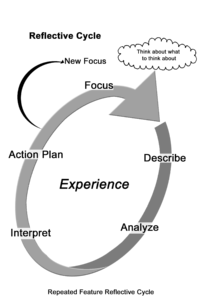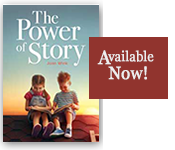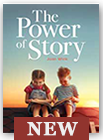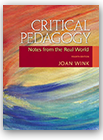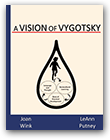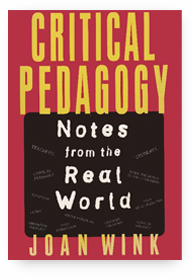Critical Pedagogy 4th Ed – Reflective Cycle Overview
Except from:
Wink, J. (2004, 4/e, pp.9-10) Critical Pedagogy: Notes from the REAL WORLD. Boston, MA: Allyn & Bacon.
As I reflect on this critical learning experience with Dayna and a classroom of teachers/MA students, I continue to learn from it. In what follows, I will move through the reflective cycle of this particular classroom experience. At the end of each chapter in the book, I will provide a reflective experience for you.
Critical pedagogy is to name, to reflect critically, and to act, as displayed in Figure 1.2. Teachers-to-be, teachers, and teacher educators reflect a lot, but a critical pedagogue must learn to reflect deeply, honestly, sometimes painfully, and often. So, the question is, How do we reflect? Here is one way.
First, you must focus on something very specific. What are you going to reflect on? For example, in this case, I am reflecting on Dayna and what can still be learned, relearned, or unlearned from this classroom experience.
Second, after experiencing something, or reading about it, or learning about it, you must describe what happened. In this case, Dayna’s words describe the experience. However, from my perspective, she is omitting a significant part of the story. During the entire thirteen-week class; she always read prior to class and was prepared to share or listen in each class. I was aware of her personal struggles as an elementary and secondary student in various traditional classrooms, in her undergraduate program, in her teacher education program, and in some graduate classes. However, in this class, Dayna was a model student except for one very important aspect. During the entire semester, Dayna had not tuned in even one required writing assignment, as listed in the syllabus. She wrote all the reflections but simply did not do the longer term papers. When I would ask her, she would say that I needed to have faith in the learner (Freeman & Freeman 1994), an idea that I had championed vigorously in class. What could I say? I had asked the teachers to have faith in their learners, and now I was being asked to live my beliefs. Week 7 came and went without a midterm writing assignment from Dayna; Week 10 came and went without a required writing assignment from her. We 13 came, and Dayna entered the class with a large hand-painted watercolor picture. She asked to share with the class; I had no idea what was coming, but I was very concerned about her lack of completed assignments. The class and I sat mesmerized as she explained her picture, and then she handed me her written document, explaining the painting.
Third, as I analyze this experience now, I question why Dayna did not reflect on her own role in the whole process. I wonder why she omitted the thirteen weeks of not turning in her papers.
Fourth, as I interpret and try to draw some judgments of this, I consider that maybe it was too unnerving to consider her own full range of power as she took control of her own learning; or perhaps, she simply ran out of time when she was preparing her assignment. She was a mom, a wife, a full-time student, and a full-time teacher.
Fifth, however it is clear that Dayna created her own action plan for her own learning as well as that of others. Without ever mentioning critical pedagogy in class, she demonstrated that One Size Fits Few (Ohanian, 1999), with her watercolor painting, she named our learning in class; she reflected critically on how to demonstrate her learning; and she took action as she painted and shared her learning. Our prescribed written assignments on the syllabus simply did not fit Dayna. If you would like to see a photo of the poster-size watercolor, see https://www.joanwink.com/wp-content/uploads/2020/08/3models_with-citation.jpg.
I have reflected on my learning from Dayna, but now I’d like you to stop reading and reflect on what you have learned from her.
“You need only claim the events of your life to make yourself yours. When you truly possess all you have been and done….you are fierce with reality.”
–Florida Scott Maxwell (1983, p. 82), an octogenarian
Dayna claimed the events of her own life, and she became fierce with reality. In what follows, I will expand upon her understandings as we continue to think about these same three approaches to pedagogy: transmission, generative, and transformative.
